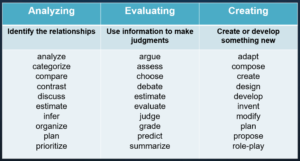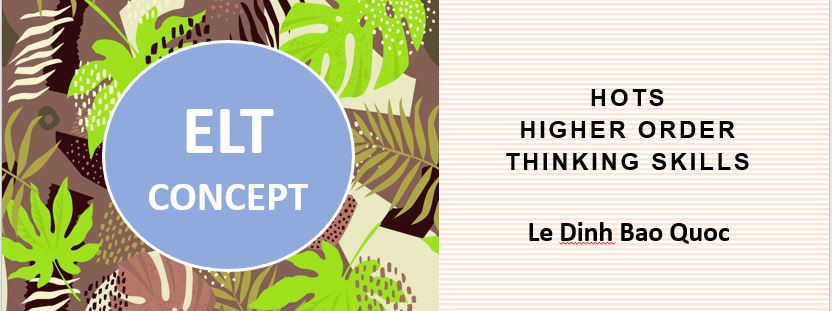ELT Concepts #17 – HOTS – Higher Order Thinking Skills
Le Dinh Bao Quoc
The popular 4Cs of the 21st-century skills – Communication, Collaboration, Critical Thinking, Creativity – have become a buzz word in education, especially in English Language Teaching. While Communication and Collaboration are quite straightforward, the other two skills are not as straightforward for both teachers and educators. Critical Thinking and Creativity belong to what educators often call HOTS (Higher order thinking skills).
What is HOTS?
HOTS is a very popular concept first in American education and then spread to other countries. These are skills that form the top portion of Bloom’s Taxonomy of Cognitive Domain.The Taxonomy was originally created by Benjamin Bloom in 1956 and later revised by a group of cognitive psychologists and scientists (see graph below).

As we can see in the pyramid, the top 3 levels involve HOTS, i.e., analyzing, evaluating, and creating. These levels are also where the two more complicated Cs in the 4Cs (Critical Thinking and Creativity) reside. If we are successful in teaching HOTS, we can expect our students to improve on their critical thinking and creativity.
Why is it important?
According to Paul and Elder (2007), “Much of our thinking, left to itself, is biased, distorted, partial, uninformed or down-right prejudiced. Yet the quality of our life and that of which we produce, make, or build depends precisely on the quality of our thought.” As a result, developing the quality of students’ thinking is a must for not only their learning but their lives as well.
HOTS can benefits students in many ways, including the following:
- Enhancing students’ ability to analyze information, evaluate data collected, and synthesize or create new ideas
- Helping students see things in different perspectives, building up their knowledge and experience.
- Developing students’ emotional intelligence, especially when dealing or working with people in the future. They know why they feel or behave that way and they can learn to control their feelings or actions when necessary.
My reflection
How you can we incorporate HOTS in your teaching? The first step to take would be for us to intentionally include HOTS in our lesson objectives. Once these get included, the next step would be to design tasks and activities that would engage students in these higher order thinking skills. The table below provides an excellent resource for teachers to plan their HOTS lesson. By using the verbs in the table below in the lesson plan, teachers can be more confident that their lesson focuses on supporting students’ critical thinking skills.

Below are some typical activities the students can do to improve their HOTs.
1. Brainstorming.
This classic technique to elicit ideas from students is good to involve HOTs for their students to practice. But remember that it depends a lot on the questions the teachers ask. Don’t use closed question like Yes/No or Or-questions. Instead, using open-ended questions which can trigger their critical thinking or creativity with step-by-step guidance from teachers. Doing this, teachers can help their students improve HOTs when they have to plan, create, judge, predict, or modify their answers.
2. Exploiting pictures

Instead of only asking explicit questions like
- What do you see in the picture?
- What is the boy doing?
- What’s the weather like?
- What do you see in the background?
We can ask the following questions
- Why is he riding his bike in the rain?
- What do you think he’s heading?
- Do you think he has a happy life?
- If you were him, what would you do?
- What would you like to ask him?
These questions will help students “do the actions” of the above table to develop their HOTs. For example, when finding answers for Why is he riding his bike in the rain?, they have to analyze and evaluate the situation, compare the situation in the photo with a normal situation, and finally develop a reason. Similarly, when they answer What would you like to ask him?, they will have to create the questions and plan their interview based on the analysis and evaluation of the boy’s situation in the photo.
3. Creating new endings for a story
Story is a fun way to learn, especially when learning a language. When the students are asked to create a new ending of a story, they develop their creativity, the top level of Bloom’s Taxonomy. In order to do it, they will have to analyze the details, summarize what happens in the story, choose what kind of ending they what to create, and propose their ending.
4. Debate
This activity is where a pool of HOTs is required for students to accomplish. Before the debate, they have to analyze information, organize, prioritize and plan how to present their ideas. During the debate, they have to argue, debate, evaluate and predict their opponent’s ideas, and summarize what their opponent said. Then after the debate, they have to judge what they did well, what not, modify their ideas and develop a new plan for the next time.
5. Project
Similar to the debate, any project requires a lot of HOTs to complete. The students have to organize their roles in the project, discuss, compare, contrast, analyze Then they will argue, debate, then choose which ideas will be used for the project. In the final phase before the presentation will adapt what they used for the project, design, develop, and propose the final product.
HOTS is not easy to teach, but they are well worth including in our teaching. One of the first things for teachers to do is to make HOTs a habit in class. Teachers should always incorporate HOTs in their lesson planning and activities, practice HOTs themselves, and encourage their students to sharpen their HOTs every day. This will take time and need consistent reinforcement and encouragement.
References:
Paul, R., & Elder, L. (2007). A guide for educators to critical thinking competency standards. Dillon Beach, CA; Foundation for Critical Thinking.
ELT Concept #16 – Language Transfer


Great insights on Higher Order Thinking Skills! I loved how you highlighted practical strategies for teachers to implement HOTS in the classroom. It’s so important for us to nurture critical thinking and problem-solving abilities in our students. Looking forward to more posts on this topic!
I really enjoyed this post on Higher Order Thinking Skills! It’s fascinating to see how these skills can transform not only language learning but also critical thinking in general. I appreciate the practical strategies you’ve shared for encouraging deeper engagement in the classroom. Looking forward to implementing some of these ideas!
Thank you for such an insightful post on Higher Order Thinking Skills! I particularly appreciated the practical examples you provided for implementing HOTS in the classroom. It’s inspiring to see how these skills can transform our teaching methods and enhance student engagement. Looking forward to more strategies in future posts!